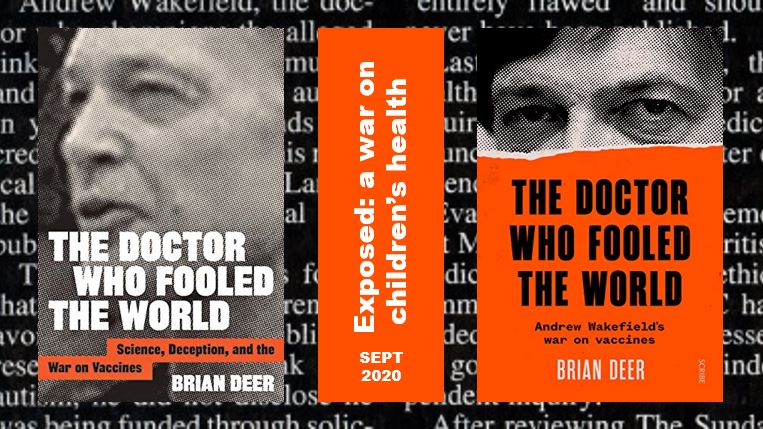
[English language editions]
Brian Deer exposes a conspiracy of fraud and betrayal behind attacks on a mainstay of medicine.
“This is a remarkable book” — The Times.
“Riveting” — Nature.
From San Francisco to Shanghai, from Vancouver to Venice, controversy over vaccines is erupting around the globe. Fear is spreading. Banished diseases have returned. And a militant “anti-vax” movement has surfaced to campaign against immunization. But why?
In The Doctor Who Fooled the World, award-winning investigative reporter Brian Deer exposes the truth behind the crisis. With the page-turning tension of a detective story, he unmasks the players and unearths the facts. Where it began. Who was responsible. How they pulled it off. Who paid.
At the heart of this dark narrative is the rise of the so-called “father of the anti-vaccine movement”: a British-born doctor, Andrew Wakefield. Banned from medicine, thanks to Deer’s discoveries, he fled to the United States to pursue his ambitions, and now claims to be winning a “war.”
In an epic investigation, spread across fifteen years, Deer battles medical secrecy and insider cover-ups, smear campaigns and gagging lawsuits, to uncover rigged research and moneymaking schemes, the heartbreaking plight of families struggling with disability, and the scientific scandal of our time.
Follow Brian on Twitter:
Reviews
“It’s a remarkable story and this is a remarkable book … helping to explain the political and social predicament that now afflicts so many of us — the crisis in truth and its exploitation by people without scruple.” — David Aaronovitch, The Times of London. Book of the Week. Books of the Year, 2020.
“Riveting … a compelling portrait of hubris and the terrible dark shadow it can cast.” — Saad B. Omer, Nature.
“Exposing researchers who lie, cheat and fake their data often requires the work of courageous whistleblowers or tenacious investigative journalists. Enter Brian Deer, an award-winning reporter for the Sunday Times of London.” — Michael Shermer, The Wall Street Journal.
“This riveting history of Andrew Wakefield’s career as an advocate for the discredited link between the measles vaccine and autism serves as a stirring demonstration of the process and power of investigative journalism.” — Publishers Weekly.
“Mind-boggling … Every chapter drops your jaw.” — Derek Beres, The Big Think.
“Although many people think they know this now-infamous story, it is likely they are unaware of all its dramatic details.” — Paul Offit, MD, Science.
“This stunning work sounds an urgent message and demonstrates the essential role of investigative journalism in uncovering the truth.” — Kristen Rabe, Foreward Reviews.
“Seldom has any new book been more timely than The Doctor Who Fooled the World … At times the book reads more like a thriller than a journalistic investigation.” — Decca Aitkenhead, The Sunday Times Magazine.
“With the meticulousness of a journalist determined to find out the truth and the pulse-pounding pacing of a thriller, The Doctor Who Fooled the World is a profoundly important book.” — Steve Silberman, author, Neurotribes: The Legacy of Autism and the Future of Neurodiversity.
“A brilliant book.” — Kevin O’Sullivan, talkRadio.
“Deer’s book is a compelling reminder of what great investigative journalism looks like, and why it matters.” — Kathleen Hall Jamieson, director, the Annenberg Public Policy Center.
“A magnificent book. Too few people know how greed and deceit conspired to create the myth that vaccines cause autism. Only Brian Deer can tell that whole story, because he uncovered all of its chilling twists and turns.” — Ivan Oransky, MD, president, the Association of Health Care Journalists, co-founder, Retraction Watch.
“Brian Deer’s definitive account of Andrew Wakefield’s fraudulent attempt to link the onset of autism in children with the MMR vaccine could not be better timed … gripping.” — Dominic Lawson, The Sunday Times.
“This brilliantly written book is a must read.” — Dr Su Laurent, author, Your Baby Month By Month: What to Expect from Birth to 2 Years.
“An extraordinary story of medical fraud and scaremongering, told by the courageous and tenacious journalist who revealed the truth.” — Simon Singh, author, Fermat’s Enigma.
“This is a gripping true detective story that reads like a thriller, with an impact on the real world that will leave you as chilled as any Stephen King novel.” Readings Best Nonfiction Books, 2020.
“A great ripping yarn of journalism.” — Andrew Mueller, Monocle Radio.
“It’s fantastic … I couldn’t put it down. It was absolutely enthralling, disturbing, and it had me on the edge of my seat the whole way through.” — Heidi Robertson, The Skeptic Zone.
“If people need any proof that the anti-vax movement is driven by anything but concern for public safety, they need look no further than Brian Deer’s excellent book, The Doctor Who Fooled the World.” — Elliot Coburn MP, speaking in the UK parliament.
“An uncomfortable page turner… Brian Deer vindicates the purpose of investigative journalism.” — Dr. Peter Lindsay, British Journal of General Practice.
“As a father to an autistic child I often am told how vaccines could be the ’cause’. This book did a great job of explaining the origin of this toxic idea and provides me something to hand family that may also be concerned and full of judgement and blame.” Nathan Roth, reader, Pennsylvania.
“The book’s author, Brian Deer, is a determined and driven investigative award-winning journalist… His grasp of medicine, immunology, vaccines, viruses etc, is remarkable.” — Prof Denis Gill, The Medical Independent.
“An incredible story.” — Chemistry World.
“A damning indictment.” — The Newtown Review of Books.
“Every doctor should read this book.” — Dr Greg Dollman, Insight.
Winner of the Eric Hoffer Award for nonfiction, 2021, and gold medal winner, Independent Publisher Book Awards, 2021.
READ HOW DEER’S WAKEFIELD
INVESTIGATION WAS CHECKED

Brian Deer is a multi-award-winning investigative reporter, best known for inquiries into the drug industry, medicine, and social issues for The Sunday Times.
Published by Johns Hopkins University Press (North America) and Scribe (UK and Commonwealth).
Follow Brian on Twitter:
POPULAR SCIENCE | TRUE CRIME | BIOGRAPHY
